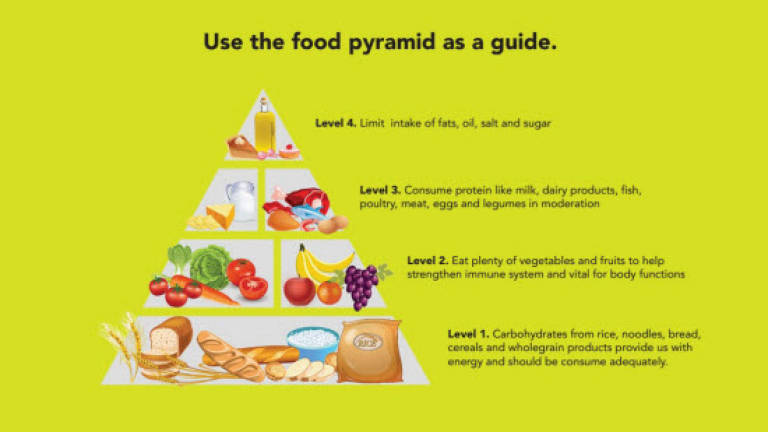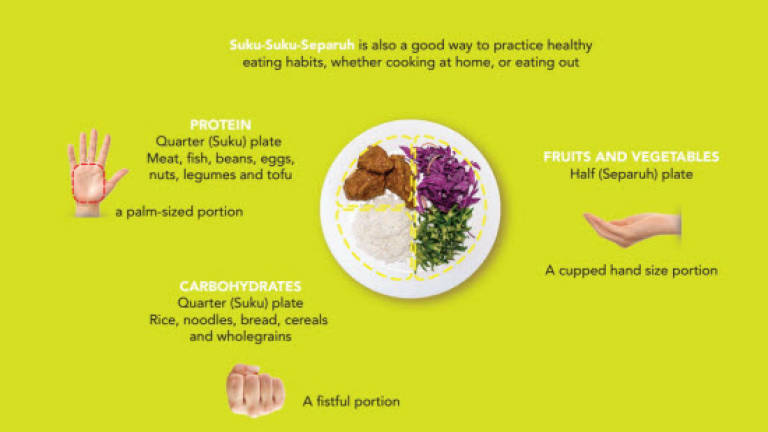A Balanced Plate is a Healthy Plate



IF you want to eat healthily, stop complicating matters by following fad diets (which often don't work), or what your favourite celebrity tells you to do.
Instead, apply the easy rule of suku-suku-separuh when it comes to portioning your food.
Based upon the Ministry of Health's nationwide campaign on The Malaysian Healthy Plate, suku-suku-separuh is an easy way to portion out the types of food that your body needs.
Since you can't carry around a measuring equipment when you visit your cafeteria, restaurant or buffet counter, the only option you have is to visually estimate how much of each type of food from the different food groups you can put on your plate.
For a properly balanced plate, one-quarter of it should be protein, the other one quarter should be carbohydrates, and half of the plate should consist of fruits and vegetables.
Our body needs proteins that can be found in meat, fish, poultry, eggs, legumes and nuts to keep us strong and healthy. A palm-sized portion is considered a great portion size.
Carbohydrates from rice, noodles, bread, cereals and wholegrain products can provide us with the energy that we need for work and play. A fistful is a great indication of the portion size you need.
Half your plate should be made up of multicolour and fibre-rich vegetables as well as fruits to help protect us from diseases and infections. A cupped hand size is a great way to give you an estimate of how much you need.
Maintaining the right balance of nutrients and ensuring you eat right, is important for your overall health and wellbeing. Many people tend to over-indulge when they eat out (something many Malaysians do) and load up their plate with foods that look tasty but are not necessarily good for them.
Thanks to poor eating habits, lifestyle diseases such as diabetes and hypertension are on the rise in this country. Exercise all you want, but if you stuff yourself with unhealthy foods afterwards, it will be all for nothing.
Use the food pyramid as a guide. Level 1 at the very bottom is for carbohydrates, and you are advised to eat food from this level adequately.
However, it is good to eat plenty of food in Level 2 which consists of vegetables and fruits, as the fibre, vitamins and minerals they provide will help strengthen your immune system and smooth out important body functions.
You should consume in moderation milk and dairy products which make up Level 3 (Group A), as the protein and calcium in these products are essential for growth, development as well repairing body tissues and building strong bones.
Also consume in moderation foods on Level 3 (Group B) such as fish, poultry, meat, eggs and legumes. These are a great source of protein, the body's building block and which is necessary to repair body tissues.
The top level, or Level 4, consists of fats, oil, salt and sugar, which is something you should take in very limited amounts as too much of it can contribute to higher risk of chronic diseases such as obesity, diabetes, cardiovascular diseases, and hypertension.
One sure way to ensure that these healthy eating habits are practised by everyone is to instil them from a young age.
For the past 22 years, MAGGI® in collaboration with the Ministry of Education and the Malaysian Dietician Association has been running MAGGI® Secondary School Cooking Competition (MSSCC).
This is not just another cooking competition, as students not only learn a valuable lifelong skill but also gain vital knowledge about food, nutrition and healthy eating.
Taking it several steps further MAGGI® created a digital platform for MSSCC this year, with the launch of the educational portal, Nurturing a Healthier Future! which provides easy access to "Healthy Eats" and "Cook Smart" tips.
Information on the platform includes essential tips on topics like the Malaysian Healthy Plate, portion control, substituting ingredients with healthier choices, how to read food labels, and proper food storage.
MAGGI® has also incorporated the concept of a balanced meal in the MSSCC, in which students are required to present their dish in the form of #sukusukuseparuh.
The concept of suku-suku-separuh is also a good way to practise healthy eating habits, whether cooking at home or eating out. Just remember how to measure the portion sizes, and consume foods in moderation.
Find further information about healthy eats at https://www.MAGGI.com.my/nurturing-a-healthier-future.